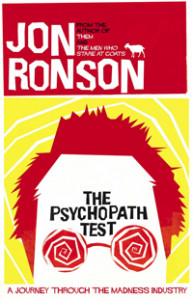The Psychopath Test
A journey through the madness industry
by Jon Ronson. Published by Picador www.picador.com
Are you mad? You probably are you know. At least by the standards of the DSM – Diagnostic and Statistical Manual of Mental Disorders – published by the American Psychiatric Association. It’s a checklist of the symptoms of every recognised mental disorder. The first edition in 1952 ran to 64 pages. The current edition (IV) has 886 pages so there’s a good chance most people reading this will fall into some category or other.
In fact, statistically speaking, at least 10 of you are psychopaths.
The dark appeal of psychopaths (or sociopaths, there’s no difference in the definition) in modern media is obviously the main lure of this book. From ‘Criminal Minds’ to slasher movies, the emotionless killing machine seems to exert an undeniable magnetism on the popular imagination. Even the current fashion for Vampires can fall under this description for what are Vampires but psychopaths with superpowers?
The eponymous ‘psychopath test’, more correctly called the Hare PCL-R Checklist, is a 20 point list used to diagnose the 1% of the population who classify as ‘psychotic’. For anyone who wants to check their friends or work colleagues against the list, you can find it on page 101 when you’re flipping through the book in Hodges Figgis or Easons.
For Jon Ronson – who previously brought you ‘The Men Who Stare at Goats’ – this exploration of what it means to be mad in the 21st Century starts when he’s asked to investigate a mysterious book sent to academics throughout the world. Ronson soon finds the new investigation dovetailing with his previous experience of the consequences of casually referring to a cult leader as a psychopath. Though it starts out reading like a detective drama (is the mysterious book a complex code, elaborate hoax or the work of a madman?), ‘The Psychopath Test’ soon settles into the more approachable documentary format of interviews with several psychiatrists as well as several alleged psychopaths. Is the man who claims to have faked madness to get a lenient jail sentence only to find himself locked up in a mental hospital indefinitely, really a danger to society? Is the multi-millionaire living in a mansion with gold lion statues a psychopath or just a ruthless businessman? Is there a difference?
These questions, and others, lead Ronson into the wider but equally murky waters of what – and who – defines mental illness at all. He finds uneasy bedfellows in the Scientologists who campaign against the massive scope of the DSM definitions. The psychiatrists – the people *defining* sanity – often seem to have more than one or two screws lose themselves – dosing prisoners with LSD, massive electric shocks and holding naked group therapy sessions.
‘The Psychopath Test’ is a wide ranging book, though, in taking on the subject of the entire psychiatric industry, the scope may have proven to be a little too wide with numerous avenues left insufficiently explored. None the less, it is a fascinating and scary read though Ronson himself comes across as somewhat ambivalent (perhaps inevitably so given the ambivalence so many of the psychiatrists display). On one hand, his writing implies heavy criticism of psychiatry and the DSM as too all-encompassing and pandering to the pharmaceutical industry. On the other, as though fearful of being too closely tied to such ostensible allies as the Scientologists, he shies away from their more extreme condemnation. That aside, the only real flaw is that the book barely touches on one intriguing theme – the preponderance of mental illness in the captains of industry and politics. In one interview Martha Stout from Harvard Medical School, says “The higher up the ladder you go, the greater the number of sociopaths you’ll find there”, while Bob Hare – who developed the PCL-R checklist – doesn’t think the individual psychopath murderer is the greatest danger. He says “Serial killers ruin families. Corporate, political or religious psychopaths ruin societies”.
These themes would make a fascinating book in themselves. I hope somebody writes it.
